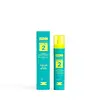What's inside
What's inside
 Key Ingredients
Key Ingredients

 Benefits
Benefits

 Concerns
Concerns

 Ingredients Side-by-side
Ingredients Side-by-side

Water
Skin ConditioningDimethicone
EmollientNiacinamide
SmoothingBetaine
HumectantLauryl PEG/PPG-18/18 Methicone
Skin ConditioningPropanediol
SolventSilica
AbrasiveDibutyl Adipate
EmollientAlcohol Denat.
AntimicrobialZinc PCA
Humectant1,2-Hexanediol
Skin ConditioningPentylene Glycol
Skin ConditioningCaprylyl Glycol
Emollient4-T-Butylcyclohexanol
MaskingSodium Acrylates Crosspolymer-2
AbsorbentPolyacrylate Crosspolymer-6
Emulsion StabilisingXylitol
HumectantCaprylic Acid
CleansingTocopheryl Acetate
AntioxidantSphingomonas Ferment Extract
Skin ConditioningCaprylic/Capric Triglyceride
MaskingGlycerin
HumectantHydroxyacetophenone
AntioxidantPentaerythrityl Tetra-Di-T-Butyl Hydroxyhydrocinnamate
AntioxidantParfum
MaskingMaltodextrin
AbsorbentBixa Orellana Seed Extract
MaskingHydrolyzed Opuntia Ficus-Indica Flower Extract
AbrasiveDisodium EDTA
Tocopherol
AntioxidantRetinal
Skin ConditioningSodium Hydroxide
BufferingPhospholipids
Skin ConditioningT-Butyl Alcohol
PerfumingCitral
PerfumingAscorbic Acid
AntioxidantWater, Dimethicone, Niacinamide, Betaine, Lauryl PEG/PPG-18/18 Methicone, Propanediol, Silica, Dibutyl Adipate, Alcohol Denat., Zinc PCA, 1,2-Hexanediol, Pentylene Glycol, Caprylyl Glycol, 4-T-Butylcyclohexanol, Sodium Acrylates Crosspolymer-2, Polyacrylate Crosspolymer-6, Xylitol, Caprylic Acid, Tocopheryl Acetate, Sphingomonas Ferment Extract, Caprylic/Capric Triglyceride, Glycerin, Hydroxyacetophenone, Pentaerythrityl Tetra-Di-T-Butyl Hydroxyhydrocinnamate, Parfum, Maltodextrin, Bixa Orellana Seed Extract, Hydrolyzed Opuntia Ficus-Indica Flower Extract, Disodium EDTA, Tocopherol, Retinal, Sodium Hydroxide, Phospholipids, T-Butyl Alcohol, Citral, Ascorbic Acid
 Reviews
Reviews

Ingredients Explained
These ingredients are found in both products.
Ingredients higher up in an ingredient list are typically present in a larger amount.
Alcohol Denat. is an alcohol with a denaturant property. It is created by mixing ethanol with other additives.
This ingredient gets a bad rep because it is irritating and drying - mostly due to its astringent property. Astringents draw out natural oils in tissue, constricting pores and leaving your skin dried out.
However, alcohol denat. is not all that bad.
Due to its low molecular weight, alcohol denat. tends to evaporate quickly. One study on pig skin found half of applied alcohol evaporated in 10 seconds and less than 3% stayed on skin.
This also helps other ingredients become better absorbed upon application.
Studies are conflicted about whether this ingredient causes skin dehydration. One study from 2005 found adding emollients to propanol-based sanitizer decreased skin dryness and irritation. Another study found irritation only occurs if your skin is already damaged.
Small amounts of alcohol are generally tolerated by oily skin or people who live in humid environments.
The rule of thumb is if this alcohol is near the end of an ingredients list, it will probably not affect your skin much.
Also...
This ingredient has antimicrobial and solvent properties.
The antimicrobial property helps preserve products and increase their shelf life. As a solvent, it helps dissolve other ingredients.
Other types of astringent alcohols include:
Learn more about Alcohol Denat.Sodium Hydroxide is also known as lye or caustic soda. It is used to adjust the pH of products; many ingredients require a specific pH to be effective.
In small amounts, sodium hydroxide is considered safe to use. However, large amounts may cause chemical burns due to its high alkaline.
Your skin has a natural pH and acid mantle. This acid mantle helps prevent harmful bacteria from breaking through. The acid mantle also helps keep your skin hydrated.
"Alkaline" refers to a high pH level. A low pH level would be considered acidic.
Learn more about Sodium HydroxideWater. It's the most common cosmetic ingredient of all. You'll usually see it at the top of ingredient lists, meaning that it makes up the largest part of the product.
So why is it so popular? Water most often acts as a solvent - this means that it helps dissolve other ingredients into the formulation.
You'll also recognize water as that liquid we all need to stay alive. If you see this, drink a glass of water. Stay hydrated!
Learn more about Water